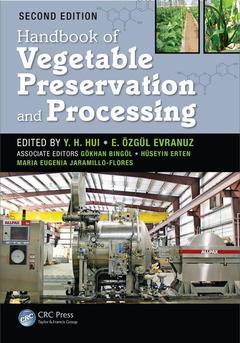Handbook of Vegetable Preservation and Processing (2nd Ed.) Food Science and Technology Series
Coordonnateurs : Hui Y. H., Evranuz E. Özgül

The second edition of a bestseller, Handbook of Vegetable Preservation and Processing compiles the latest developments and advances in the science and technology of processing and preservation of vegetables and vegetable products. It includes coverage of topics not found in similar books, such as nutritive and bioactive compounds of vegetables; vegetable flavors and sensory properties; genetic engineering; vegetable pests and diseases; active and intelligent packaging; additives and preservatives; quality preservation and/or improvement; computer and control applications; specialties like winter squash and pumpkin, seed sprouts and shalgam; GAP and food safety, among others.
New Topics in the Second Edition include:
- Flavors and sensory perception
- Waste and by-products
- Genetic engineering
- HACCP
- Traceback
- Quality assurance
Food processing and agro-industries face the scientific and technical challenges of increasing the production of vegetables. This extensively revised, reorganized, and expanded second edition brings together the expertise of almost 70 scientists and product experts from around the world to give you unparalleled coverage in terms of depth and breadth.
BIOLOGICAL, CHEMICAL, NUTRITIONAL, AND MICROBIOLOGICAL ASPECTS OF VEGETABLE PRODUCTION. Vegetables as Sources of Nutrients and Bioactive Compounds: Health Benefits. Healthy Dietary Fibers from Plant Food By-Products. Vegetable Flavors and Sensory Characteristics. Use of Genetic Engineering: Benefits and Health Concerns. Important Pests in Vegetable Crops. Commercially Important Vegetable Crop Diseases. PRESERVATION AND PROCESSING TECHNOLOGY: PRINCIPLES AND APPLICATIONS. Thermal Processing: Canning and Aseptic Processing. Dehydration of Vegetables. Refrigeration and Frozen Preservation of Vegetables. Fermentation, Pickling, and Turkish Table Olives. Novel Thermal and Nonthermal Processing Technologies. Application of Vacuum Impregnation in Vegetables. Active and Intelligent Packaging for Fruits and Vegetables. Additives and Preservatives. Quality Preservation and Safety of Minimally Processed Vegetables. Quality Monitoring and Management during Storage and Distribution of Frozen Vegetables. Strategies for Controlling Major Enzymatic Reactions in Fresh and Processed Vegetables. Computer and Control Applications in a Vegetable-Processing Plant.PROCESSED VEGETABLES AND SPECIALTIES. Brassica Vegetables. Carrot Processing. Eggplant. Cultivated Mushrooms: Preservation and Processing. Greek Table Olives Processing. Peppers and Spice Capsicums. Potato and Potato Processing Technology. Production and Handling of Tomato with a High Nutrition Quality. Vegetable Seed Sprouts. Winter Squash and Pumpkins. FERMENTED AND PICKLED VEGETABLE PRODUCTS. Fermented Plant Products from Tropical and Warm Countries. Fermented Vegetable Juices and Health Attributes. Fermented Red Beet Juice. Fresh and Pickled Jalapeño Peppers: Volatile and Nonvolatile Compounds. Role of Lactic Acid Bacteria in the Fermentation and Biopreservation of Plant-Based Foods. Pickles and Sauerkraut: Manufacturing Sanitation. Soymilk and Tofu Manufacturing. Shalgam (Åžalgam): A Traditional Turkish Lactic Acid Fermented Beverage Based on Black Carrot. VEGETABLES PROCESSING SAFETY. Quality Assurance in Vegetable Processing: State of the Science in Practice in the 2010s. U.S. Regulatory Requirements for Sanitation and Safety of Processing Vegetables. Good Agricultural and Handling Practices. Quality and Safety Aspects of Vegetables.
Y. H. Hui, the president of Science Technology System in West Sacramento, California and American Food & Nutrition Center, received his Ph.D. degree from the University of California at Berkeley. YH Hui is the president of Science Technology System in West Sacramento, California and American Food & Nutrition Center. He has authored, coauthored, edited, or coedited more than 70 professional books in food science, food technology, food engineering, and food laws. He has guest-lectured in universities in North, Central, and South America as well as Europe, and Asia and served as a consultant for the food industries, with an emphasis on food sanitation and food safety.
E. Özgül Evranuz after graduating from the Chemical Engineering Department of Middle East Technical University (METU, 1971) in Ankara, Turkey, she began her academic career in the area of food technology. She holds M.S. degrees in chemical engineering (METU) and food science and management (University of London, Queen Elizabeth College) and a Ph.D. degree in chemical engineering (ITU). She is among the builders of Food Engineering Department of ITU and has served as Professor (1994-2012) of food processing in that department. Her main interests are preservation, storage, and packaging of food plant materials. She has served as a book editor and has several publications in the field.
Date de parution : 11-2015
17.8x25.4 cm
Thème de Handbook of Vegetable Preservation and Processing :
Mots-clés :
Ri Ne; lactic; Sweet Corn; acid; Green Peach Aphid Myzus Persicae; bacteria; Moisture Content; starter; Log CFU; cultures; Fresh Cut Produce; phenolic; Starter Cultures; compounds; fermented; Lab Strain; osmotic; Table Olives; dehydration; Bok Choy; RFID Tag; Lactic Acid Bacteria; Sauerkraut Fermentation; Frozen Vegetables; Enzymatic Browning; Probiotic Strains; Mung Bean Sprouts; Olive Fermentations; Homofermentative Lactic Acid Bacteria; Leafy Vegetables; Carrot Juice; Minimally Processed Products; Gm Crop; Tofu Making



